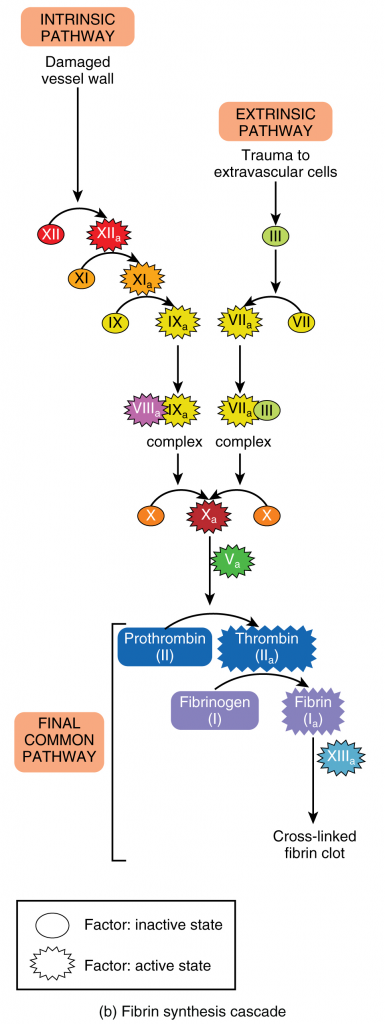
Physiology
Basic Cellular
Regarding the coagulation cascade, the intrinsic pathway requires which of the following clotting factors:
Answer:
The intrinsic pathway begins when factor XII comes into contact with a negatively charged surface area, such as a negatively charged platelet and is then activated to factor XIIa. Factor XIIa activates factor XI to factor XIa which, in turn, converts factor IX to factor IXa. Activated factor IXa forms a complex with factor VIIIa, forming the intrinsic tenase complex factor IXa-VIIIa which activates factor X in the same way as the extrinsic pathway.Coagulation Cascade
Physiology / Basic Cellular / Blood and Blood Flow
Last Updated: 11th April 2022
Blood coagulation involves a biological amplification system in which a few initiation substances sequentially activate by proteolysis a cascade of circulating precursor proteins (the coagulation factor enzymes) which culminates in the generation of thrombin; this, in turn, coverts soluble plasma fibrinogen into fibrin. Fibrin enmeshes the platelet aggregates at the sites of vascular injury and converts the unstable primary platelet plug into a firm, definitive and stable haemostatic plug.
The generation of thrombin is a complex network of amplification and negative feedback loops to ensure a localised and limited production. Generation of thrombin is dependent on three enzyme complexes, each consisting of protease, cofactor, phospholipids and calcium. The operation of this enzyme cascade requires local concentration of circulating coagulation factors at the site of injury. Surface-mediated reactions occur on exposed collagen, platelet phospholipid and tissue factor.
Initiation
Coagulation is initiated after vascular injury by the interaction of the membrane bound tissue factor (TF, factor III), exposed and activated by vascular injury, with plasma factor VII. The factor VIIa-tissue factor (extrinsic factor Xase) complex activates both factor IX and factor X. The factor Xa, in the absence of its cofactor, forms small amounts of thrombin from prothrombin. This is insufficient to initiate significant fibrin polymerisation; amplification is needed. The initiation pathway is rapidly inactivated by tissue factor pathway inhibitor (TFPI).
Amplification
The amplification phase takes place on the surface of platelets. The small amount of thrombin generated during the initiation phase activates nearby platelets and also cofactor V on their surface. Cofactor VIII is normally bound to plasma von Willlebrand factor (VWF), which protects it from degradation. Thrombin cleaves factor VIII from VWF and activates it, when it also binds to the platelet surface. The end product is a large number of activated platelets covered with active cofactors.
Propagation
Thrombin activates a short cascade that leads to activation of factor IX (also activated by the extrinsic factor Xase). The intrinsic Xase, formed by IXa and VIIIa on phospholipid surface in the presence of Ca2+, activates sufficient Xa. Factor Xa, in combination with Va, phospholipid and Ca2+, forms the prothrombinase complex and results in the explosive generation of thrombin. Thrombin hydrolyses fibrinogen to form fibrin monomers which link spontaneously to form a loose insoluble fibrin polymer. Factor XIII is also activated by thrombin and stabilises the fibrin monomers with the formation of covalent bond cross-links.

Coagulation Cascade. (Image by OpenStax College [CC BY 3.0 (https://creativecommons.org/licenses/by/3.0)])
Report A Problem
Is there something wrong with this question? Let us know and we’ll fix it as soon as possible.
Loading Form...
- Biochemistry
- Blood Gases
- Haematology
| Biochemistry | Normal Value |
|---|---|
| Sodium | 135 – 145 mmol/l |
| Potassium | 3.0 – 4.5 mmol/l |
| Urea | 2.5 – 7.5 mmol/l |
| Glucose | 3.5 – 5.0 mmol/l |
| Creatinine | 35 – 135 μmol/l |
| Alanine Aminotransferase (ALT) | 5 – 35 U/l |
| Gamma-glutamyl Transferase (GGT) | < 65 U/l |
| Alkaline Phosphatase (ALP) | 30 – 135 U/l |
| Aspartate Aminotransferase (AST) | < 40 U/l |
| Total Protein | 60 – 80 g/l |
| Albumin | 35 – 50 g/l |
| Globulin | 2.4 – 3.5 g/dl |
| Amylase | < 70 U/l |
| Total Bilirubin | 3 – 17 μmol/l |
| Calcium | 2.1 – 2.5 mmol/l |
| Chloride | 95 – 105 mmol/l |
| Phosphate | 0.8 – 1.4 mmol/l |
| Haematology | Normal Value |
|---|---|
| Haemoglobin | 11.5 – 16.6 g/dl |
| White Blood Cells | 4.0 – 11.0 x 109/l |
| Platelets | 150 – 450 x 109/l |
| MCV | 80 – 96 fl |
| MCHC | 32 – 36 g/dl |
| Neutrophils | 2.0 – 7.5 x 109/l |
| Lymphocytes | 1.5 – 4.0 x 109/l |
| Monocytes | 0.3 – 1.0 x 109/l |
| Eosinophils | 0.1 – 0.5 x 109/l |
| Basophils | < 0.2 x 109/l |
| Reticulocytes | < 2% |
| Haematocrit | 0.35 – 0.49 |
| Red Cell Distribution Width | 11 – 15% |
| Blood Gases | Normal Value |
|---|---|
| pH | 7.35 – 7.45 |
| pO2 | 11 – 14 kPa |
| pCO2 | 4.5 – 6.0 kPa |
| Base Excess | -2 – +2 mmol/l |
| Bicarbonate | 24 – 30 mmol/l |
| Lactate | < 2 mmol/l |

